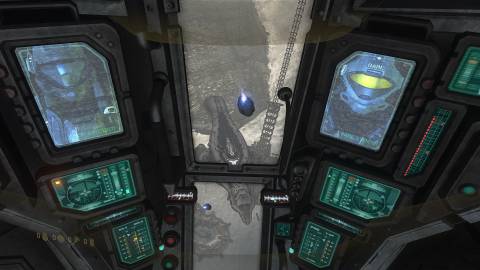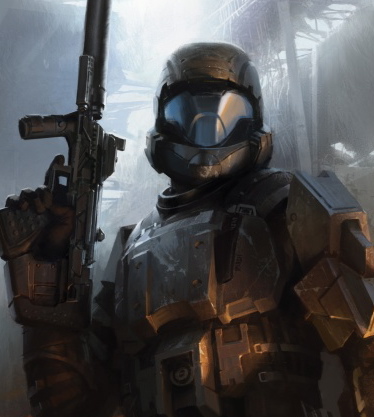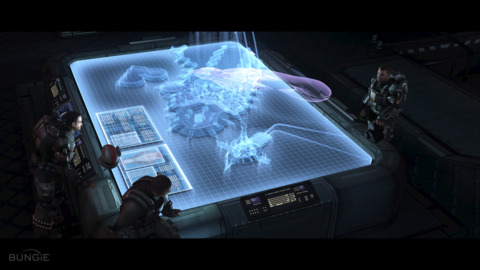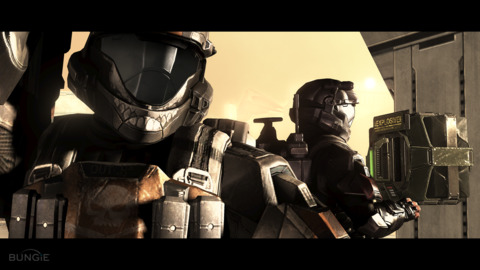
In ODST, you'll play as an ODST--that's Orbital Drop Shock Trooper. These are the guys that launch down from the sky in pods, and they represent some of Earth's best soldiers. But the key is that the ODSTs are still merely human. They aren't genetically engineered badasses like the Master Chief. So the characters you play as here are a little more fragile than the shielded and armored super trooper you're used to controlling in Halo games. They aren't tough enough to dual-wield weapons. They aren't rough enough to hijack enemy vehicles. They aren't strong enough to pull off that huge, floaty jump that the Master Chief has. They aren't crafty enough to collect and deploy equipment like you could in Halo 3. And they don't have health that automatically recharges when you take damage. That said, the ODSTs still have shields of some sort. It's referred to as "stamina" in-game, but it serves the same purpose as the Chief's shields and recharges when you stay out of battle for a few seconds. Your health meter--the one that gets rocked when you get caught while out of stamina--doesn't recharge on its own. To rectify health issues, you'll have to seek out medkits, which are usually plentiful enough to make health loss a non-issue. Beyond these changes, the ODSTs you'll control in the campaign are roughly equivalent to the big Spartan.
The other big change in ODST is that these guys are equipped with different helmet-based heads-up displays. The new HUD--which comes from your visor and is helpfully called VISR--comes with a light amplification option that brightens things up and enhances the edges of objects. This is handy, as significant portions of the campaign are done under cover of darkness. The edge enhancement is especially cool in the darkest areas. The lines it draws around the edges of things makes the game look like some kind of militaristic Tron arena or something. While you don't have a motion sensor, hitting the back button brings up a map of the city, showing you where you need to go, nearby enemies, and more. The map screen, also, looks really nice. The key reason for having a map--as well as an on-screen compass that directs you to waypoints--is that a chunk of ODST is played in a sort of open-world hub that links the game's missions together.

As you work your way through the city, you may run into one of the 30 audio clips hidden there. These are designed to be a basic collectible and to give you a reason to run around the entire city, rather than just sticking to the critical path and heading from one mission to the next. The clips string together to form a fairly interesting story that's set around the time of the Covenant first landing at New Mombasa. It also gives you some insight into the nature of the Superintendent, which is a city-wide AI that subtly guides you around the city by changing video screens around town to big detour arrows aimed in the direction of your next objective or a nearby audio log. The story that plays out in these audio logs is tied to the game's story, but it features more interesting characters than the actual game does. The Rookie doesn't speak, which sort of makes him the most interesting character by default. The rest of the ODST crew chats it up, but a lot of that dialogue feels forced, with plenty of generic-sounding military talk. And the all-too-convenient romantic past between the ODST squad leader and the female naval intelligence officer doesn't bring any heat to the proceedings.
The campaign kept me going for just under seven hours on the game's "heroic" difficulty setting. Like Halo 3 before it, the developers recommend that players familiar with the series start at this setting. On normal or lower, the combat is painfully easy--which is fine if you're a novice, but won't be much fun for anyone else. On the highest setting, again known as legendary, the game becomes much more of a challenge, making it something that's best suited for cooperative play. Like Halo 3 before it, ODST allows up to four players to play via Xbox Live or LAN. It's a fun way to play, though there's something cool about the solitary nature of The Rookie's portion of the journey that doesn't feel quite right when you're rolling around with three partners.

If that was the complete package, ODST would be a pretty good expansion type of package, provided it was available at an expansion sort of price. But there's a second disc in the package that offers every bit of Halo 3's competitive multiplayer, including all of the downloadable maps that have been made available via the Xbox Live Marketplace since Halo 3's release. It's a weird offering, because I find it hard to believe that anyone thinking about buying ODST doesn't already have Halo 3. And in the case of fanatical Halo fans, chances are they already paid for one or more of the map packs when they were released digitally. The one catch is that this disc, marked "Halo 3: Mythic," comes with three maps that will be exclusive to this collection. It's a convenient disc for Halo 3 multiplayer fans to own, but it feels like something that was tacked onto the collection in order to further justify the package's $59.99 price tag... and it's something that a sizable piece of the game's prospective audience probably already owns.

Halo 3: ODST fills in a few interesting spots in the Halo timeline, even if the characters themselves aren't strong enough to carry the narrative. But it strikes a healthy balance between new twists and more content done in Bungie's trademark style. The more important thing is that if you've enjoyed playing Bungie's Halo games in the past, chances are you'll continue to enjoy that style in ODST.
Disclosure: The game featured in this review is or was an advertised product on giantbomb.com.